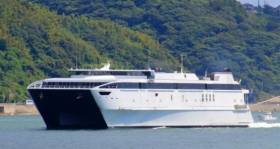Displaying items by tag: ICG new fastferry
#FerrytoUSnavy - Irish Continental Group (ICG) which acquired a fastferry for $13.25 million last month has taken delivery this week of the HSC (high-speed craft) Westpac Express from BALI Westpac 2006, LLC, writes Jehan Ashmore.
The HSC has been onward delivered by ICG to Sealift LLC who has in turn chartered the fastferry to the U.S Navy's Military Sealift Command (MSC), a government organisation that controls the replenishment and military transport ships of the navy.
The charter is subject to usual US government procurement regulations and is fixed for a firm 4 month period to 30 September, with charterer's options to extend the charter period to a maximum of 59 months in total.
The vessel was built in 2001 by Austal Ships, Australia. It has a gross tonnage of 8,403 tonne, passenger capacity of 900 and a car carrying capacity of 182 units. Afloat adds that Irish Sea operator, the Isle of Man Steam Packet's fastferry Manannan built by a rival of Austal, InCAT based in Hobart, Tasmania, had also served a career with the US Navy's MSC.
Westpac Express is not the only ICG vessel on charter as the former Irish Sea ropax Isle of Innisfree currently the Kaitaki is bareboat chartered ( i.e. without crew) to a third party in New Zealand.
The custom-built 22,365 tonnes cruiseferry 'Innisfree' which became ICG's first newbuild since acquiring the ailing state-owned B&I Line, began operating for Irish Ferries until replaced by larger tonnage.
For almost the last decade Kaitaki has operated Interislander's Wellington-Picton route having entered service in August 2006. The 1,650 passenger/ 600 car/ 108 truck cruiseferry serves the Cook Strait service linking the north and south islands.
























































